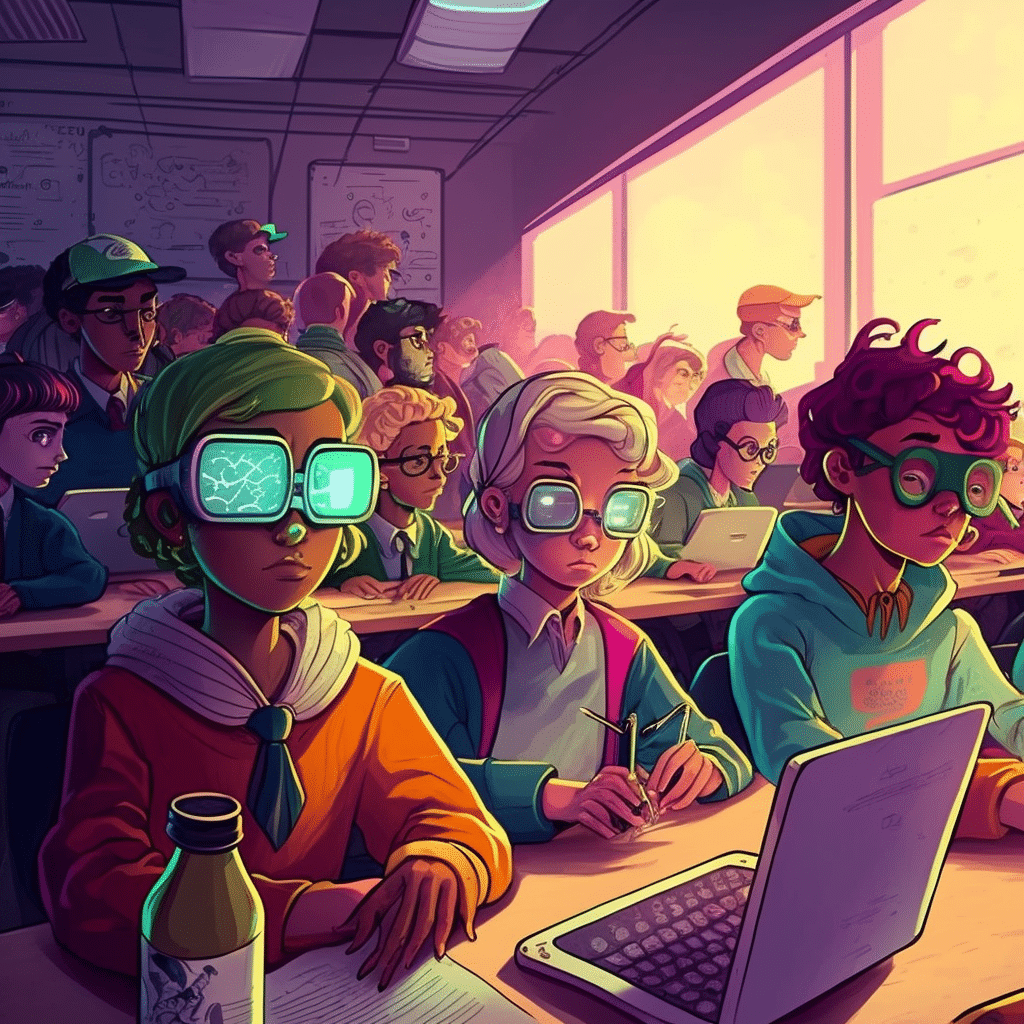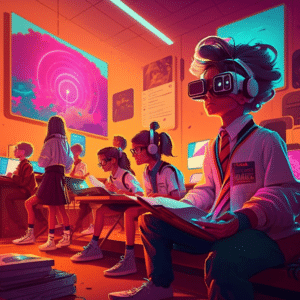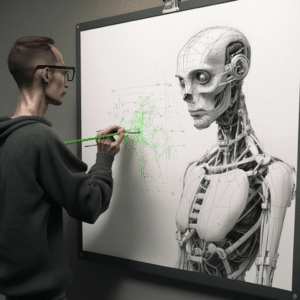
Unboxing the Future of Education:
“A Sneak Peek into a Day in the Life of a Student in 2040”
As we propel into the future (we all know it is coming, obviously), the world of education is set to undergo significant transformations, spoken about at length by the LinkedIn community. From advanced technology to personalized learning, the educational landscape of 2040 is likely to look vastly different from what we know today. But what will a typical day in a student’s life in 2040 look like?
To explore this question, I collaborated with my new friend Chat GPT to create a concept of what a day in the life of a 2040 student might look like. The results were fascinating, providing a glimpse into the possible future of education (To conduct a thorough and accurate foresight project, it is crucial to explore multiple potential futures. While the scenario presented here is intended to be playful and imaginative, it represents only one possible outcome among many. I encourage readers to share their scenarios and perspectives in the comments, as this will help to create a more robust and diverse exploration of the future.).
Ultimately this was created through a lot of questioning, re-questioning and reflections (by me, maybe Chat GPT, who knows at this point) on the possible outcomes the AI gave.

AI determined that the day would begin within a welcoming and technologically advanced school environment, technology would be king. AI technology is prevalent throughout the day, providing personalized feedback and assessment (are our current LMS systems doing this, or is this a sneak peek into the future). Project-based learning and hands-on experiences are a significant part of the curriculum (which was good news for the THINK Learning Studio), allowing students to apply their knowledge to real-world problems.
“Education is not preparation for life; education is life itself.” (John Dewey)
One potential area of change is the start time for school, which in our concept was still around 8:00 am; during my time as a principal, I tried to push the start time back as much as possible, given the known benefits of a later start time for teenagers. I challenged the AI on why schools can’t adapt to the teenage brain; however, the AI gave some solid reasons for this being unlikely across the board (including traditional expectations and transport availability).
I am cool with Chat GPT highlighting my ideas are lacking structure and are unrealistic.
In 2040, students can access various daily resources and tools, such as virtual reality, coding software, and 3D printers. The learning environment is personalized, immersive, and collaborative, allowing students to explore their interests and develop new skills.
I did more of a deep dive into the Metaverse (virtual reality) to extract the AI’s thoughts on if this was a moment in time or going to be something that is persistent technology; my passion here is that at THINK Global School during my time, the Metaverse was a significant arc to my future school vision, alongside the use of ChatBots and Blockchain, I am a somewhat surprised by its pause in impact (this point I appreciate, is very much up for debate):
In addition, the Metaverse could potentially provide opportunities for students to connect and collaborate with other learners from around the world. The virtual nature of the Metaverse would allow for students to work together in a seamless, immersive environment, regardless of their physical location. This could help to break down barriers to collaboration and foster a sense of community among learners.
However, it is also possible that the Metaverse may not be as impactful as some predict. There are still many technical, ethical, and societal issues that need to be addressed before the Metaverse can become a mainstream technology. It may take years, even decades, before the technology is sophisticated enough to create truly immersive and interactive environments for learning.
The AI collaboration enabled us (me!) to imagine a future where technology plays a crucial role in education. We envisioned a world where virtual assistants, personalized learning programs, and advanced technological tools are integrated into the learning environment. This is not to say that human interaction is miscalculated; the concept has the teacher by the AI was more of a mentor, guiding and mentoring the students, providing feedback, encouragement and inspiration.
Of course, the reality of the future of education may not be exactly as AI imagined it. Still, this collaboration allowed us to explore the possibilities and get a sense of what the future of education could hold, and trigger some conversation.
Take a look at the AI-generated timetable here:
8:00 AM – Arriving at School As I walk into the school building, I am greeted by a welcoming environment. The hallways are brightly lit and decorated with student artwork. The school is equipped with the latest technology, including interactive displays and virtual reality tools. I swipe my ID card at the entrance, which logs my attendance and opens my digital locker.
8:15 AM – Morning Meeting My class begins with a morning meeting, which is conducted virtually. My teacher greets us and reviews the day’s objectives. We share our ideas and collaborate on upcoming projects. Our virtual meeting is facilitated by an artificial intelligence (AI) assistant, which helps to manage the discussion and provide feedback.
9:00 AM – Core Curriculum Our morning continues with core curriculum subjects such as math, science, and language arts. These subjects are taught through a combination of virtual and in-person instruction. The AI assistant provides personalized feedback and assessment, and we use a variety of tools such as simulations and games to help us learn.
11:00 AM – Project-Based Learning After a short break, we move on to project-based learning. This is where we apply our knowledge to real-world problems and collaborate with our peers. We have access to a variety of tools and resources, such as 3D printers, coding software, and virtual labs. Our teacher acts as a mentor, guiding us through the project and providing feedback.
12:00 PM – Lunch and Recreation Lunch is a social event, and we have access to a variety of healthy and delicious food options. After lunch, we have time for recreation and exercise. The school has a variety of indoor and outdoor spaces, including a gym, a swimming pool, and a nature trail.
1:00 PM – Electives and Special Programs In the afternoon, we have time for electives and special programs. We can choose from a variety of courses, such as music, art, robotics, or entrepreneurship. We can also participate in internships, apprenticeships, or community service programs. These experiences allow us to explore our interests and develop new skills.
3:00 PM – Reflection and Wrap-Up At the end of the day, we take time to reflect on what we have learned and set goals for the future. We use digital portfolios to document our progress and showcase our achievements. Our teacher provides personalized feedback and encouragement, and we leave the classroom feeling empowered and inspired.
In closing, will a day in the life of a “2040 student” look vastly different from what we know today?
Will it be a personalized, immersive, collaborative experience where technology is integral to learning? Will future collaboration between humans and AI enable a dynamic, adaptive and personalized learning environment that allows individuals to explore their interests, develop new skills, and prepare themselves for the challenges and opportunities of the future? What will be the magnitude of AI’s impact?

In response to our collaborative moment, I would like to pose three guiding questions to the audience:
How might we re-imagine education to create a more holistic and meaningful learning experience for our students as we move forward towards 2040?
How might we cultivate a sense of curiosity, wonder, and creativity in our students, and how might this foster a deeper engagement with learning?
How might we expand the definition of “education” beyond the confines of the classroom and foster lifelong learning and growth in our students?
Think Learning Studio Team Notes –
- The fact that the AI still included Core Curriculum in the timetable was intriguing and noteworthy.
- The facilitation of the emerging AI technology was fully integrated into the learning experience, providing an innovative and dynamic educational environment.
- One aspect of the day that I found particularly interesting was the reflective practice at the end, which allowed students to process and internalize their learning experiences.










